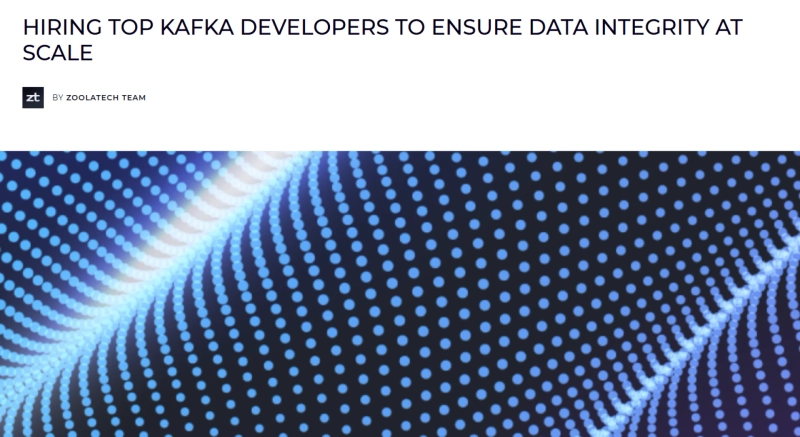Modern software systems must process enormous volumes of data, adapt quickly to business changes, and remain reliable under high load. Traditional monolithic architectures, though easier to start with, often struggle to meet these expectations. As organizations scale, they increasingly turn to microservices—a modular approach to software design that emphasizes independence, scalability, and flexibility.
Yet, building microservices alone doesn’t guarantee success. The real challenge lies in enabling communication among these services efficiently, especially when dealing with real-time data flows. That’s where Apache Kafka comes into play.
Kafka has become the cornerstone of event-driven architectures (EDA), allowing microservices to communicate asynchronously through event streams. This approach enables systems to respond to changes in real time, decouple services, and maintain robustness even as components evolve independently.
In this article, we’ll explore how to build microservices using Kafka, dive into the most effective event-driven design patterns, and examine how companies such as Zoolatech and other leading software engineering firms leverage Kafka to power distributed systems.
Why Kafka Is Essential for Modern Microservices
Before diving into design patterns, it’s crucial to understand why Kafka has become such a powerful tool for microservice communication.
1. Decoupling Services
In a monolithic application, modules are tightly integrated—any change in one part can ripple through the system. In contrast, Kafka enables loose coupling through its publish-subscribe model.
Instead of services calling each other directly (which can lead to cascading failures), they publish events to Kafka topics. Other services that need the data simply subscribe to those events.
This separation of concerns allows each service to evolve independently, be deployed separately, and scale on demand.
2. High Throughput and Scalability
Kafka was designed to handle billions of messages per day. Its distributed, partitioned log system allows data to be processed in parallel across multiple brokers. This makes it ideal for large-scale systems that require real-time processing, analytics, and reliable event streaming.
3. Reliability and Fault Tolerance
Kafka stores data in durable logs that can be replayed, ensuring that no event is lost. This guarantees at-least-once delivery—a critical feature for event-driven systems where every action (like processing a payment or creating an order) must be accounted for.
4. Real-Time Stream Processing
Kafka integrates seamlessly with frameworks like Kafka Streams, ksqlDB, and Flink, allowing real-time data processing. This means microservices can react immediately to business events, making it possible to build responsive systems for analytics, fraud detection, recommendation engines, and more.
Understanding Event-Driven Architecture (EDA)
At its core, event-driven architecture is built on the idea that systems should react to changes (or “events”) as they happen.
An event represents a state change — for example:
- “OrderCreated”
- “PaymentProcessed”
- “UserRegistered”
In an EDA, producers emit these events, and consumers react to them asynchronously. Kafka acts as the central nervous system, transmitting events reliably across the ecosystem.
Key Components of Event-Driven Architecture
- Event Producers
- These are microservices that generate events. For instance, when a customer places an order, the Order Service produces an “OrderCreated” event.
- Event Consumers
- These are services that react to events. A Payment Service might consume “OrderCreated” to trigger payment authorization.
- Event Brokers (Kafka)
- Kafka sits in the middle, handling event distribution. It ensures durability, ordering, and replayability of messages.
Core Event-Driven Design Patterns for Kafka-Based Microservices
Let’s explore some of the most effective event-driven design patterns that enable scalability, resilience, and flexibility when building microservices with Kafka.
1. Event Notification Pattern
This is the simplest and most commonly used pattern. In this design, an event contains minimal information—just enough to notify other services that something happened.
For example, when a new order is placed, the Order Service publishes an “OrderCreated” event. The event might include only the order ID.
Other services, like Inventory or Shipping, then query the Order Service for details.
Advantages:
- Lightweight messages.
- Easy to implement.
Drawbacks:
- Creates temporal coupling since consumers still depend on the producer being available for data retrieval.
2. Event-Carried State Transfer Pattern
In this pattern, the event carries all relevant state information about the change. For instance, the “OrderCreated” event might include order ID, product list, quantity, and customer details.
This eliminates the need for consumers to call back to the producer, promoting true decoupling.
Advantages:
- Consumers have all the data they need.
- Reduces service dependencies.
Drawbacks:
- Larger message sizes.
- Potential data duplication.
3. Event Sourcing Pattern
Instead of storing only the final state of a business entity, Event Sourcing keeps a log of all changes as a sequence of events.
For example, instead of storing “OrderStatus: Shipped,” the system records a chain of events like:
- OrderCreated
- PaymentProcessed
- ItemPacked
- OrderShipped
The current state can always be reconstructed by replaying the events.
Benefits:
- Perfect audit trail.
- Enables time travel and debugging.
- Ideal for analytics and machine learning.
Challenges:
- Complex to implement.
- Requires robust schema evolution management.
4. CQRS (Command Query Responsibility Segregation) Pattern
In many systems, reading and writing data have different requirements. CQRS separates commands (writes) from queries (reads).
Kafka works perfectly for implementing this pattern:
- Command services publish events (like “UserUpdated”).
- Query services consume those events and build optimized read models.
This design increases performance, scalability, and allows different storage solutions for read and write models.
5. Saga Pattern (for Distributed Transactions)
Microservices often need to maintain data consistency across boundaries—such as processing an order and charging a payment.
The Saga pattern coordinates multiple local transactions through choreography or orchestration:
- Choreography: Each service listens to events and reacts accordingly. For example, the Payment Service reacts to “OrderCreated,” and the Shipping Service reacts to “PaymentProcessed.”
- Orchestration: A central Saga orchestrator controls the flow of events, invoking services and handling rollbacks if needed.
Kafka’s event streaming capabilities make it ideal for both approaches, allowing services to remain autonomous yet coordinated.
Real-World Implementation Considerations
When implementing Kafka-based microservices, teams—especially experienced kafka developers—must consider several architectural and operational aspects.
1. Schema Management
Schema evolution is one of the biggest challenges in event-driven systems. Using Apache Avro or JSON Schema Registry helps maintain compatibility between producers and consumers, ensuring that data changes don’t break existing services.
2. Idempotency and Exactly-Once Processing
Since events can be replayed or redelivered, consumers must be idempotent—processing the same message multiple times should yield the same result.
Kafka’s transactional API helps achieve exactly-once semantics (EOS), ensuring that messages are processed reliably without duplication.
3. Monitoring and Observability
With asynchronous communication, debugging can be tricky. It’s essential to have robust monitoring, tracing, and logging. Tools like Prometheus, Grafana, and OpenTelemetry are invaluable for tracking message flow and system health.
4. Error Handling and Dead Letter Queues
When message processing fails, it’s important not to lose those messages. Kafka supports Dead Letter Queues (DLQs)—special topics for storing failed events. Developers can analyze these to fix issues or replay them later.
5. Security and Compliance
For enterprises handling sensitive data, Kafka offers SSL/TLS encryption, SASL authentication, and ACL-based authorization. Compliance with GDPR or financial regulations often depends on correctly configuring these features.
The Role of Kafka in Building Reactive Systems
In addition to event-driven design, Kafka aligns naturally with the Reactive Manifesto, which emphasizes systems that are:
- Responsive
- Resilient
- Elastic
- Message-Driven
Kafka’s backpressure management, partitioned scalability, and fault-tolerant replication ensure that each of these principles is achievable in practice.
Reactive systems built with Kafka can automatically adapt to load changes, recover gracefully from failures, and maintain consistent user experiences even under unpredictable conditions.
Use Cases: Kafka-Powered Microservices in Action
Kafka’s versatility allows it to serve as the backbone for diverse use cases across industries:
- E-Commerce Platforms
- Handle orders, inventory updates, and payment events in real time, ensuring accurate stock levels and faster order fulfillment.
- Financial Services
- Power fraud detection systems and transaction auditing pipelines with low latency and guaranteed data consistency.
- Telecommunications
- Process streaming data from millions of devices to monitor network performance and predict outages.
- Healthcare
- Manage patient records and IoT medical device streams while maintaining compliance and auditability.
- Logistics and Supply Chain
- Enable live shipment tracking and predictive analytics based on event-driven telemetry data.
Companies like Zoolatech, known for their expertise in custom software engineering and cloud-native systems, often leverage Kafka to design distributed systems for clients across these industries. Their approach emphasizes modularity, resilience, and scalability—values that align perfectly with event-driven microservice architectures.
Best Practices for Building Kafka-Based Microservices
To maximize the effectiveness of your Kafka-driven architecture, consider the following best practices:
- Model Events Carefully
- Treat events as first-class citizens. Use clear, descriptive names and maintain versioning.
- Keep Topics Granular
- Avoid mixing unrelated event types in the same topic. This keeps consumers simple and efficient.
- Implement Backpressure Controls
- Use consumer groups and partitioning wisely to prevent bottlenecks.
- Leverage Kafka Connect
- For integrating external systems like databases, CRM platforms, or cloud services, Kafka Connect provides pre-built connectors that simplify data ingestion and delivery.
- Automate Deployment and Scaling
- Combine Kafka with Kubernetes or Docker for elastic scaling and automated failover.
- Train Your Team
- Building event-driven systems requires a shift in mindset. Experienced kafka developers are invaluable for ensuring smooth adoption and avoiding common pitfalls.
Challenges and How to Overcome Them
While Kafka offers tremendous power, organizations often face several challenges when transitioning to an event-driven model:
1. Cultural Shift
Teams accustomed to synchronous REST APIs must embrace asynchronous thinking. This shift requires training, patience, and leadership buy-in.
2. Data Duplication
Events often contain overlapping data. Employ schema registries and versioning to manage redundancy.
3. Debugging Complexity
With multiple independent services, tracing a business process across topics can be difficult. Implement distributed tracing early to mitigate this.
4. Operational Overhead
Running Kafka clusters at scale demands expertise in tuning brokers, managing partitions, and ensuring data replication. Managed Kafka services (like Confluent Cloud or AWS MSK) can simplify this.
Future of Event-Driven Microservices with Kafka
The future of distributed systems is real-time and event-centric. Kafka continues to evolve, with new features like KRaft mode (removing ZooKeeper), tiered storage, and tighter integrations with stream processing frameworks.
As AI and machine learning workloads increasingly depend on continuous data flows, Kafka will become even more integral to model training pipelines, anomaly detection, and personalization engines.
Enterprises adopting event-driven design patterns today are positioning themselves for agility, scalability, and innovation tomorrow.
Conclusion
Building microservices with Kafka represents a fundamental evolution in software architecture. By embracing event-driven design patterns, organizations can achieve systems that are decoupled, resilient, and responsive to change.
Kafka provides the backbone for this transformation—enabling real-time data exchange, seamless scalability, and robust fault tolerance.
Whether you’re architecting a financial trading platform, an e-commerce engine, or a healthcare data system, adopting Kafka’s event-driven paradigm unlocks new possibilities for innovation and efficiency.
Firms like Zoolatech have demonstrated how combining microservices, cloud-native principles, and Kafka expertise can produce scalable, future-ready digital ecosystems. As the role of kafka developers continues to expand, mastering event-driven architecture will be one of the most valuable skills in the evolving software landscape.



